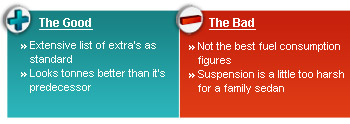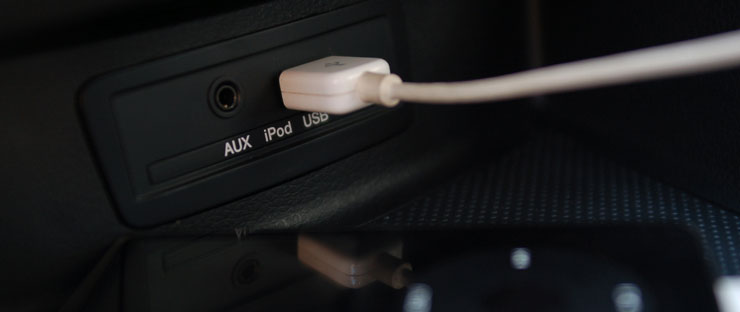Kia Magentis 2.0 (A) Review
27 May 2009|33,838 views
 After the launch of the Forte earlier in the year, it looked like Kia was taking a great new direction with their cars, a more European direction.
After the launch of the Forte earlier in the year, it looked like Kia was taking a great new direction with their cars, a more European direction. Since they were rescued from bankruptcy by Hyundai in 1998, the Kia brand has been set on a more focused North-Eastern path in an effort to tap the European market more effectively.
To do exactly that, they roped in the same bloke who designed the original Audi TT, Peter Schreyer, to design Kia's Cerato replacement, the Cerato Forte. And he did a great job on that car's physical appeal didn't he?
Swooping headlights that ooze sporty aspirations, crease lines flowing from the headlights to the taillights, and a fairly handsome rear-end sealed this car as a favourite of both local and foreign media.
Just like how Peter's design influence is still easily identified in Audi's latest line-up (he worked at Audi for eight years and was responsible for the A6 and Audi TT design), the new design language is starting to sprout out across the board at Kia.
Starting with the 2009 face-lifted Magentis.
Exterior
So now the Magentis gets a predictably great snout as well, with the Kia emblem sitting proudly in the middle of the honeycomb net that fills the yaw of the gapping chromed-mouth. Flanked by those swooping headlights that hint at a sporty nature, the softer angled lines retains a maturity that is missing from the smaller Forte.
To accommodate the new changes, the front gets a new bumper that doesn't add much on its own, but compliments the brave styling above it effectively. Then you have the new retractable side-mirrors with built-in indicators that make this car seem more expensive than it really is.
To cap off the list of changes are the rear tail lamps.
Although not drastic enough for most of us to point out immediately, the chunk designers took out of the inner portion of those lamps gives people enough of an indication that the car's new, only if it's at the lights next to a Magentis taxi though.
As much as I was impressed with the ambition conveyed from the Magentis's new fascia, it was what greeted me on the inside that really got me re-educated about the ambitious Korean car company.
 |
Small touches, big difference
Now the steering wheel gets three buttons on either side that makes it all the more convenient for you when changing radio stations, the mode and the volume while driving.
Look past that and a sportier, revised instrument cluster greets you. It especially looks great in the evenings when the speedometer figures are back-dropped in a red glow. The trip computer resides below.
iPod connection! I have no idea how some manufacturers can leave this out but thankfully it's standard on the Magentis.
The big surprise for me was the sunglass holder. I haven't seen enough of this little feature in the cars I've tested recently, absolutely forgot how useful this really is.
A hook, which sits flushed on the right side of the centre console on the passenger side of the car is another nifty feature. A handbag hook they call it. I call it the 'tau huay' hook. All you have to do is slide your finger at the bottom to bring out the hooked end from hiding.
Great when you're like me and have those insatiable 'tau huay' (Chinese dessert made from an extra soft form of tofu in sweet syrup) midnight cravings, but realise you have to drive slowly through corners back home so you don't throw the containers all around and break up the fragile whole scoops of tofu that you put so much pleasure in tucking into.
Need to access your boot? Dread the reach-down to tug the fuel cap release? Both functions are served conveniently with buttons for each situated at the bottom half of the driver-side door.
Driving it
The 2.0-litre in-line four engine gives the Magentis more than enough poke when moving about the urban roads and over-taking on the highways. It's a DOHC engine (Double Overhead Camshaft) so when you're smashing the throttle, the torque and horsepower peaks higher than in a SOHC (Single Overhead Camshaft) engine. And peaks it does, at around 6,200 rpm.
At that limit, you're rudely awakened by all the 164 horses that get this almost one and a half tonne Magentis to 100km/h in a respectable 11.1 seconds. That's almost a second faster than sister car, the Sonata. The note from the engine, when running full-on, is not sporty and neither is it adrenaline-stimulating though.
 |
It's more like a wall of noise that urges you to change your mind about stomping the accelerator the next time you have the urge for speed. Torque figures stand at 197 Nm at 4,600 rpm.
But the real beauty of the Magentis, in my opinion of course, is the handling. The car's steering feel has been set up to be "more sporty" at higher speeds, which means you get a much more predictable and weighted feel when carving those corners.
But you've got all the power controlled by a four speeder, the same unit in the Forte we tested. Would have rather it been paired to a five-speed box though, that way we could harness a more smile-inducing power band and the car could possibly achieve a better fuel consumption figure as well. So expect the sporty nature of the car to end at the handling.
The Macpherson Struts in the front and Multi-link setup at the rear is a tried and tested combination across most brands, but on the Kia you feel the stiffness especially going over road imperfections at higher speeds.
Just some annoyance I had with the car was that every time I employed my direction-signals, the "tick-tick" sound came from the passenger side of the dash instead from the driver's side. What's worse is that it sounded exactly like how it would in a Toyota Crown taxi.
I'm sure it's something we could get used to, but it just doesn't sound right.
When slotting the gears, the accompanying plastic cover moves along with the shift, which works against the car's initial quality proposition. Just when you think that's where the cheap plastics end, you've got the handbrake that jiggles about each time you grab it. Again, not working towards the car's image.
 |
The verdict
Magentis has been associated with the taxi for some time now and breaking away from that image with such a sporty fascia design does wonders for the brand.
That's one side of the coin though, because besides the stigma the Kia is suffering with our taxi fleet, the Korean marquee has long been associated with inferior build quality and terrible fuel economy.
In fact, even I used to think that the reason they made the cars cheap was because owners would need the extra money for petrol.
Over my two nights with the car, with both hard acceleration and economical drives, through highway and small roads, the consumption figures read 6.7 km/litre (converted from 14.9 litres/100 km). That's almost two kilometers less than what Kia claims to be getting. Keep in mind though that the car wasn't properly run in when I picked it up. Then throw in the fact that it has been put through it's paces back-to-back by journalists and the figure gets easier to swallow. So for those who buy the Magentis, expect your consumption figures to be hovering near Kia's claimed 9 km/litre.
What we have here is one of the best looking sedans in the segment at the moment. And it only gets better once you've read the host of equipment that comes standard on this car.
Steering wheel audio controls. Auto headlights. Auto rain sensing wipers. Auto climate control. Dual airbags. Electro-chromic rear-view mirror. Electronically-folding side mirrors. Electronically-adjustable driver seat. iPod connection. Infinity sound system and subwoofer. 16" alloys wheels.
All this at $60,999 with COE. To make it even more irresistible, Kia has gone and introduced an introductory offer of $59,999.
With the offer sitting in front of you, you start realising that this car is really not too bad. And the stigma that the Magentis suffers with being a taxi?
Rubbish. It's common sense.
If you operated a taxi fleet, you'd want the best packaged car at the best price as well wouldn't you?
 After the launch of the Forte earlier in the year, it looked like Kia was taking a great new direction with their cars, a more European direction.
After the launch of the Forte earlier in the year, it looked like Kia was taking a great new direction with their cars, a more European direction. Since they were rescued from bankruptcy by Hyundai in 1998, the Kia brand has been set on a more focused North-Eastern path in an effort to tap the European market more effectively.
To do exactly that, they roped in the same bloke who designed the original Audi TT, Peter Schreyer, to design Kia's Cerato replacement, the Cerato Forte. And he did a great job on that car's physical appeal didn't he?
Swooping headlights that ooze sporty aspirations, crease lines flowing from the headlights to the taillights, and a fairly handsome rear-end sealed this car as a favourite of both local and foreign media.
Just like how Peter's design influence is still easily identified in Audi's latest line-up (he worked at Audi for eight years and was responsible for the A6 and Audi TT design), the new design language is starting to sprout out across the board at Kia.
Starting with the 2009 face-lifted Magentis.
Exterior
So now the Magentis gets a predictably great snout as well, with the Kia emblem sitting proudly in the middle of the honeycomb net that fills the yaw of the gapping chromed-mouth. Flanked by those swooping headlights that hint at a sporty nature, the softer angled lines retains a maturity that is missing from the smaller Forte.
To accommodate the new changes, the front gets a new bumper that doesn't add much on its own, but compliments the brave styling above it effectively. Then you have the new retractable side-mirrors with built-in indicators that make this car seem more expensive than it really is.
To cap off the list of changes are the rear tail lamps.
Although not drastic enough for most of us to point out immediately, the chunk designers took out of the inner portion of those lamps gives people enough of an indication that the car's new, only if it's at the lights next to a Magentis taxi though.
As much as I was impressed with the ambition conveyed from the Magentis's new fascia, it was what greeted me on the inside that really got me re-educated about the ambitious Korean car company.
 |
Small touches, big difference
Now the steering wheel gets three buttons on either side that makes it all the more convenient for you when changing radio stations, the mode and the volume while driving.
Look past that and a sportier, revised instrument cluster greets you. It especially looks great in the evenings when the speedometer figures are back-dropped in a red glow. The trip computer resides below.
iPod connection! I have no idea how some manufacturers can leave this out but thankfully it's standard on the Magentis.
The big surprise for me was the sunglass holder. I haven't seen enough of this little feature in the cars I've tested recently, absolutely forgot how useful this really is.
A hook, which sits flushed on the right side of the centre console on the passenger side of the car is another nifty feature. A handbag hook they call it. I call it the 'tau huay' hook. All you have to do is slide your finger at the bottom to bring out the hooked end from hiding.
Great when you're like me and have those insatiable 'tau huay' (Chinese dessert made from an extra soft form of tofu in sweet syrup) midnight cravings, but realise you have to drive slowly through corners back home so you don't throw the containers all around and break up the fragile whole scoops of tofu that you put so much pleasure in tucking into.
Need to access your boot? Dread the reach-down to tug the fuel cap release? Both functions are served conveniently with buttons for each situated at the bottom half of the driver-side door.
Driving it
The 2.0-litre in-line four engine gives the Magentis more than enough poke when moving about the urban roads and over-taking on the highways. It's a DOHC engine (Double Overhead Camshaft) so when you're smashing the throttle, the torque and horsepower peaks higher than in a SOHC (Single Overhead Camshaft) engine. And peaks it does, at around 6,200 rpm.
At that limit, you're rudely awakened by all the 164 horses that get this almost one and a half tonne Magentis to 100km/h in a respectable 11.1 seconds. That's almost a second faster than sister car, the Sonata. The note from the engine, when running full-on, is not sporty and neither is it adrenaline-stimulating though.
 |
It's more like a wall of noise that urges you to change your mind about stomping the accelerator the next time you have the urge for speed. Torque figures stand at 197 Nm at 4,600 rpm.
But the real beauty of the Magentis, in my opinion of course, is the handling. The car's steering feel has been set up to be "more sporty" at higher speeds, which means you get a much more predictable and weighted feel when carving those corners.
But you've got all the power controlled by a four speeder, the same unit in the Forte we tested. Would have rather it been paired to a five-speed box though, that way we could harness a more smile-inducing power band and the car could possibly achieve a better fuel consumption figure as well. So expect the sporty nature of the car to end at the handling.
The Macpherson Struts in the front and Multi-link setup at the rear is a tried and tested combination across most brands, but on the Kia you feel the stiffness especially going over road imperfections at higher speeds.
Just some annoyance I had with the car was that every time I employed my direction-signals, the "tick-tick" sound came from the passenger side of the dash instead from the driver's side. What's worse is that it sounded exactly like how it would in a Toyota Crown taxi.
I'm sure it's something we could get used to, but it just doesn't sound right.
When slotting the gears, the accompanying plastic cover moves along with the shift, which works against the car's initial quality proposition. Just when you think that's where the cheap plastics end, you've got the handbrake that jiggles about each time you grab it. Again, not working towards the car's image.
 |
The verdict
Magentis has been associated with the taxi for some time now and breaking away from that image with such a sporty fascia design does wonders for the brand.
That's one side of the coin though, because besides the stigma the Kia is suffering with our taxi fleet, the Korean marquee has long been associated with inferior build quality and terrible fuel economy.
In fact, even I used to think that the reason they made the cars cheap was because owners would need the extra money for petrol.
Over my two nights with the car, with both hard acceleration and economical drives, through highway and small roads, the consumption figures read 6.7 km/litre (converted from 14.9 litres/100 km). That's almost two kilometers less than what Kia claims to be getting. Keep in mind though that the car wasn't properly run in when I picked it up. Then throw in the fact that it has been put through it's paces back-to-back by journalists and the figure gets easier to swallow. So for those who buy the Magentis, expect your consumption figures to be hovering near Kia's claimed 9 km/litre.
What we have here is one of the best looking sedans in the segment at the moment. And it only gets better once you've read the host of equipment that comes standard on this car.
Steering wheel audio controls. Auto headlights. Auto rain sensing wipers. Auto climate control. Dual airbags. Electro-chromic rear-view mirror. Electronically-folding side mirrors. Electronically-adjustable driver seat. iPod connection. Infinity sound system and subwoofer. 16" alloys wheels.
All this at $60,999 with COE. To make it even more irresistible, Kia has gone and introduced an introductory offer of $59,999.
With the offer sitting in front of you, you start realising that this car is really not too bad. And the stigma that the Magentis suffers with being a taxi?
Rubbish. It's common sense.
If you operated a taxi fleet, you'd want the best packaged car at the best price as well wouldn't you?
Car Information
Kia Magentis 2.0 (A)
CAT B|Petrol|12.8km/L
Horsepower
122kW (164 bhp)
Torque
197 Nm
Acceleration
11.1sec (0-100km /hr)
This model is no longer being sold by local distributor
All Used Kia MagentisThank You For Your Subscription.








































